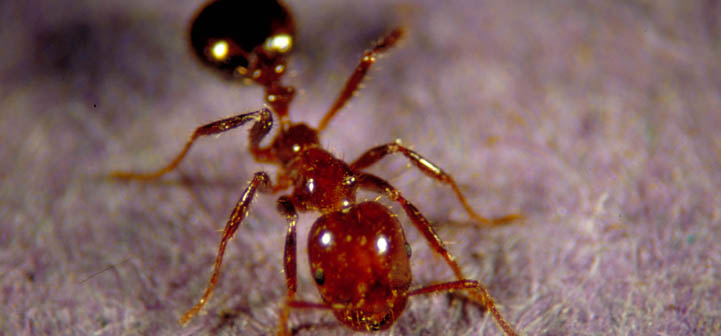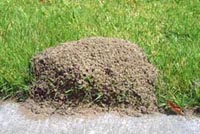How a Fire Ant Stings
Thousands of fire ants live in just one fire ant nest. If a mound is disturbed, hundreds of ants immediately rush out, climb on whatever disturbed them, including humans, and sting. There is some debate about what triggers the ants to sting at the same time instead of individually. Generally, it will take 10 to 20 seconds after climbing up on the victim for the stinging to begin
Single worker ants can bite and sting several times. The worker attaches to the skin with its chewing mouth parts (mandibles) pulling the skin, pinching it, and raising it slightly. This causes a pricking sensation. Then the ant arches its back, doubling under its abdomen, and forces the stinger into the skin. After inflicting the first sting, it may remove the stinger and, rotating or pivoting the head, may sting several more times, leaving a circular pattern of sting sites.
Many ants can sting a person at the same time. Because large numbers of worker ants are together in a nest, incidents usually involve multiple stings. When a person disturbs a fire ant mound by stepping into it, hundreds of ants can rapidly crawl (1.6 cm per second) up the person’s leg. Within seconds, they begin stinging almost simultaneously. Multiple stings can lead to severe medical reactions, even in people with normal immune systems. Infants, neurologically compromised people, the elderly, and otherwise immobile or unaware individuals are at a higher risk of multiple stinging incidents. Such people should not be left alone in fire ant infested areas. See Fire Ant Stings Can Be Serious.
The Stinger, Poison Gland and Venom

Stinger – The stinger on worker ants is a modified egg-laying structure called an ovipositor. Worker ants are sterile females incapable of producing eggs, so their ovipositors are stingers. Male ants, wasps, and bees do not possess stingers.
Poison gland – A poison gland containing venom is attached to the stinger. Queen and winged reproductive (unmated queen) ants also have a poison gland. However, they do not use their ovipositors as stingers, as do worker ants.
Venom – The venom of imported fire ants is produced in the poison gland. It contains two major components: alkaloids and proteins. The oily aliphatic alkaloids (i.e., the piperidine alkaloid, Solenopsin A) are toxic to cells. Piperidine is a relative of piperine, the main chemical ingredient in black pepper.
The piperidine toxin kills the cells at the site of injection and causes a burning sensation. This causes the body’s defensive white blood cells to accumulate at the injection site, forming a white pustule. If the skin is broken by scratching, bacteria may enter, causing an infection.
The venom also contains a protein (less than 1 percent) that has little or no effect on most people. However, for those who are sensitive to these proteins, a sting can lead to a major allergic reaction called anaphylaxis, the most severe type being anaphylactic shock. Left untreated, anaphylactic shock can lead to death within minutes.
Reactions to Fire Ant Stings
People vary greatly in their sensitivity to fire ant stings, with some claiming to be resistant to the venom. Others are hypersensitive to venom or may have other medical conditions (e.g., heart conditions, diabetes) that can result in serious medical problems or even death from a single sting. Secondary bacterial infection can also occur, sometimes requiring longer-term medical attention. While most people can tolerate many stings, severe allergic reactions (anaphylaxis) occur in less than 1 percent of people stung by fire ants.
Localized skin reaction to venom. The site of the sting hurts for a few minutes and then reddens; then it swells into a bump or hive within 20 minutes. The intense burning sensation that occurs when the venom is injected accounts for the popular name of “fire ant.”
Within several hours to a day after being stung, most people develop white, fluid-filled pustules. No other ants are known to cause this type of reaction. The pustules last for several days, and they may become infected and require medical attention. For most people, the pustules dry up in several weeks, but for some people the pustules may lead to a brown scar that can last for many months or become permanent. Although stings are not usually life-threatening, they can be easily infected if the skin is broken.
Whole body reactions. The symptoms of anaphylaxis can include dizziness, nausea, sweating, low blood pressure, headache, and shortness of breath. If even one of these symptoms occurs, the person requires immediate medical attention. Anaphylactic shock can lead to death. People who show symptoms associated with anaphylactic shock should seek advice from an allergist before entering known fire ant infested areas. Other syndromes that have been attributed to fire ant stings include neuropathy, seizures, cerebrovascular incidents, and nephrotic syndrome.
Source: Fire Ant Project Fact Sheet, Medical Problems and Treatment Considerations for Red Imported Fire Ant Stings
Treating Fire Ant Stings
Remove the stinging ants. Because worker ants use their jaws (mandibles) to gain leverage to sting, they are fixed tightly to the skin or clothing. Merely jumping into water or running water across ants from a spigot will not remove them. The best method is to rub them off briskly by hand or using a cloth.
For minor stinging incidents. With the only symptoms being pain and the development of pustules, stings can be treated with over-the-counter products that relieve pain and prevent infection. For more information, consult your pharmacist or physician.
For severe stinging incidents. If a sting causes severe chest pain, nausea, severe sweating, loss of breath, serious swelling, or slurred speech, the person should be taken to an emergency medical facility immediately.
Avoiding Fire Ant Stings
The best way to avoid medical emergencies associated with fire ants is to prevent being stung. Learn to recognize threatening situations.
- Look for fire ant mounds and take care not to stand on or near them.
- Teach children about fire ant hazards.
- Alert visitors to your landscape that fire ant mounds are present.
- Wear protective clothing during outdoor activities that might take place near fire ant nests. Wear boots or tuck pant legs into socks.
- Control ants where they occur in areas used frequently by people and pets.
- Use insect repellents on clothing or footwear. These treatments may temporarily discourage foraging ants.
- Use quick defensive reaction. Imported fire ant workers aggressively defend their nests from invaders. When fire ant mounds are disturbed, worker ants quickly rush to the surface and climb up on any vertical objects such as grass blades, sticks, or legs of people or animals that are standing on or near the nest. To avoid being stung, remove the ants as quickly as possible.
- Do not disturb ant nests. Although large, visible ant mounds are easy to avoid, smaller mounds or nests with little worked soil can be stepped on inadvertently. Colonies can also be formed under sidewalks, asphalt, rocks, wood, or debris on the ground. Furthermore, stepping on a mound may be unavoidable in some areas where there are more than 200 mounds per acre, as found in areas infested with the multiple queen (polygyne) form of the fire ant. Colonies frequently migrate from one site to another on the surface of the ground or in cracks during dry periods. Ants in migrating colonies are highly defensive and should be avoided. Also, during flooding conditions, colonies are capable of floating in clusters, posing a threat to anything encountering them.
- Watch for foraging ants (ants looking for food). People weeding in landscape beds or vegetable gardens or walking through tall vegetation can encounter foraging worker ants. These ants will readily sting, particularly when caught under cloths or pinched in folds of skin. Fire ant mounds have underground tunnels produced by worker ants that lead to openings where foragers emerge. Upon discovering needed resources, foraging ants recruit other worker ants to those sites. Thus, edges of bodies of water, trash cans and areas with spilled food or sugary drinks become areas where large numbers of foraging workers congregate.
- Sometimes fire ants invade indoors. Fire ant workers can easily enter structures through tiny cracks and crevices and forage in and around laundry, pet bowls, or other areas where they can find food and water. Occasionally, entire colonies will migrate into structures and nest in wall voids or other locations. This is particularly common when conditions outdoors become very hot and dry or when flooding occurs in the immediate landscape. Fire ants have been known to move into beds of children or immobile people. A number of serious multiple stinging incidents have occurred indoors in Texas (Drees 1995) and elsewhere (deShazo et al. 1999).
Source: Fire Ant Project Fact Sheet, Welcome to Texas! Avoiding the Sting of Fire Ants
Additional Information About Fire Ant Stings
Fire Ant Project Fact Sheet, Diagnosing and Treating Animals for Red Imported Fire Ant Injury





